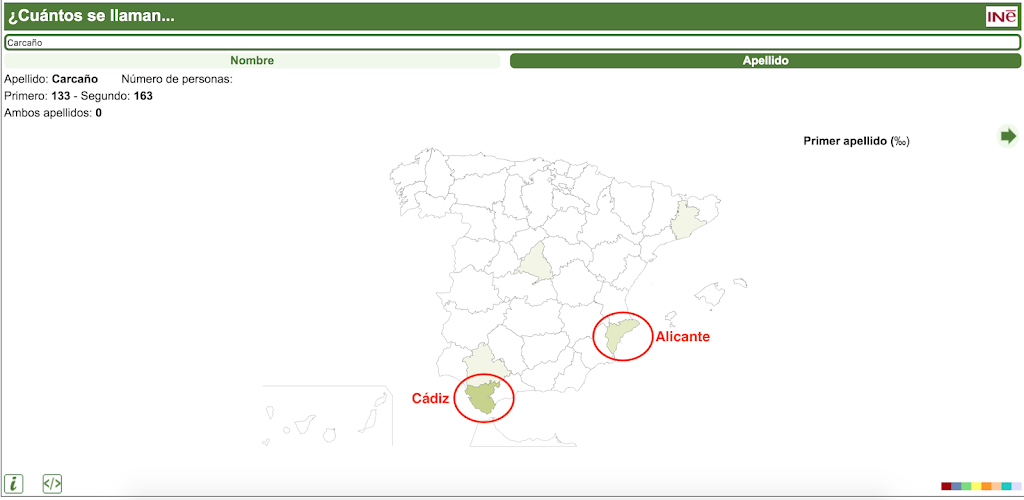Out of these four lines – Correa, Carcaño, Rodríguez, and Ruiz, I have only been able to discover more information about only a few. Here are some links to previous posts on my blog about these lines.
Correa– Summarizing my research about my family, though I am currently stuck.
Rodríguez– Writing about my 6th Great-Grandfather during the 52 Ancestor Challenge.
Manuel Ruiz– Discovering that my 7th Great-Grandfather was a pardo slave in Coamo.
The Carcaño line (as well as the Correa line) has been extremely difficult to trace. So I wanted to focus a bit on what I know on the Carcaño and some theories in hopes of being able to discover more about my 6th great-grandmother.
CARCAÑO AS A SURNAME
Besides seeing the surname Carcaño in the marriage record of my 5th great-grandparents, it has not been a surname I often see in my genealogical searches. So first, I wanted to research the surname itself outside of Puerto Rico. I wanted to know how popular the surname might be in Spain. I have mentioned the use of the INE before (Intituto Nacional Estadística) and it is one of the main ways I check how or where a surname could have arrived to Puerto Rico from within Spain. Searching “Carcaño” didn’t give me many hits, as you can see below the surname is used only by 100+ people and limited to a few regions in Spain. You can see that Cádiz and Alicante seem to be the “highest” concentration of Carcaño surnamed people in Spain and it makes a few appearances in Madrid and Barcelona. Since the surname is so limited, I would imagine these separate family branches are tied to each whether distantly or more closely related.
The version “Carcano” shows only about 20 people in Madrid using this variation, by the way!
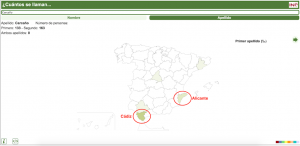 |
| Carcaño Surname Map [INE] |
CARCAÑO… ¿GENOVÉS?
My searching on the internet brought me to an article from Torrevieja that mentions a family reunion of the Carcaño branch bringing together about 150 family members. It also states that the family came to Spain from Genova, Italy around 1810 probably fleeing the siege of Napoleon, the first registered Carcaño in Torrevieja occurred in 1820.
 |
| Carcaño Family Reunion [DiarioInformación] |
This would lead me to believe that the Carcaño family entered through Alicante (the region where Torrevieja is located) and from there the family spread to other regions. Could this mean that the surname has its origins in Italian rather than Spanish? It would explain why it isn’t as commonly found in Spain and why it’s harder to find in Puerto Rico as well.
My search for María Eugenia Carcaño took me to the San Juan church records in the early 1700s. So far, I have yet to find a marriage record for María Eugenia Carcaño and her husband Juan Francisco Correa, but I did run into another Carcaño branch which was interesting to find. Since I have no idea how, if at all, this branch is tied to me I decided to build out a tree and see what I could find on them. Even if they aren’t related to me I hope that my research benefits another Carcaño family.
The first Carcaño branch I found was a marriage record for a Manuela Carcaño to a Juan Ferregut in the San Juan church records in the year 1777. Below you can see a snippet of the wedding record, stating that Juan Ferregut was from Pa[r]ma (Palma), Mallorca, the legitimate son of Guillermo Ferregut and Catalina Villa and Manuela Carcaño, a resident of this city [San Juan], the daughter of Josef Carcaño and Manuela Polanco, she deceased.
 |
| Manuela Carcaño, San Juan, Marriage, 1777 [FamilySearch] |
Since José de León Correa was said to have been born in the 1790s in San Juan, I figured that Manuela could easily be a sister to María Eugenia, as their ages were probably in the same ballpark range. So I wanted to discover more about José Carcaño and Manuela Polanco, who were they and could they have been my 7th great-grandparents?
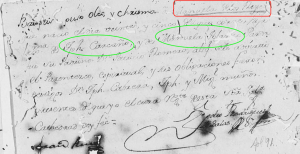 |
| Manuela Carcaño, San Juan, Baptism, 1764 [FamilySearch] |
Something extremely odd here is the math! If Manuela would have been born in 1764 and married in 1777, this would mean that she was only 13 years old when she married! Her marriage record does not mention her actual age or her needing permission from her father to get married. I have also yet to find another baptism for another Manuela Carcaño, so it is possible that the age was fudged either on the baptism or marriage. I’m not sure how common it was for girls to marry this young in the 1700s, I do however have a case of one of my 2nd great-grandmothers marrying at the age of 15 (based off her baptism and marriage records) in 1906, so it’s very possible that was common amongst certain families for status reasons.
 |
| José Carcaño + Manuela Polanco, San Juan, Marriage, 1763 [FamilySearch] |
José Carcaño was said to be a native of Genova, from the Spanish kingdom, the son of De[c]iderio and Francisca Carcaño, Manuela Polanco was a native of this city [San Juan] and the daughter of Alonso Polanco and María del Rosario, she was deceased. It’s interesting to see that José Carcaño is also tied to the community of Carcaños in Genova! It seems that for a while the Republic of Genoa aligned itself with the Spanish Empire to help in the decline it was experiencing, which is probably why in Puerto Rico it was mentioned as a part of the Spanish Kingdom.
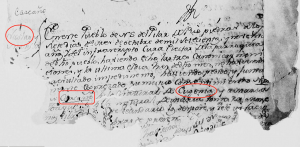 |
| Nicolás Carcaño, Río Piedras, Marriage, 1790 [FamilySearch] |
Nicolás would have been born in the 1770s, though a bit older than José de León, this wouldn’t be completely impossible for him to be a brother. The interesting thing here though is that no father is listed for Nicolás meaning he would have been a “Carcaño” and not a “Correa Carcaño”. Still, I figured it was worth an investigation.
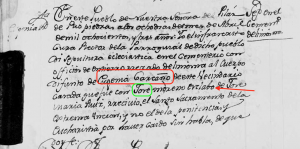 |
| Eugenia Carcaño, Río Piedras, Death, 1803 [FamilySearch] |
Here you can see a Eugenia Carcaño, resident of Río Piedras, married to “José”, black, slave of José María Ruiz, she died in April of 1803. Though I was hopeful at first, a few things don’t match with my 6th great-grandmother. The husband’s name for example was different and neither Juan Francisco Correa or Eugenia Carcaño showed up as enslaved or moreno libre in Coamo. Could she have remarried? Possible. Could she have been moreno libre in Río Piedras and her son listed as pardo libre in Coamo. Also possible.
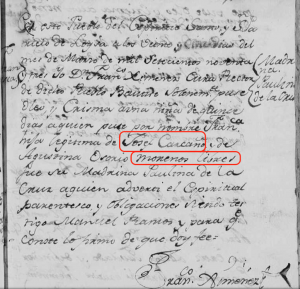 |
| José Carcaño, moreno libro, 1793 [FamilySearch] |
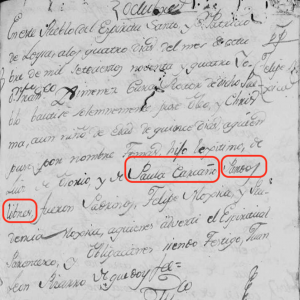 |
| Paula Carcaño, Pardo Libre, 1794 [FamilySearch] |
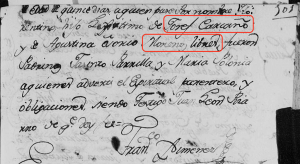 |
| First Twin of José Carcaño, Moreno Libre, 1795 [FamilySearch] |
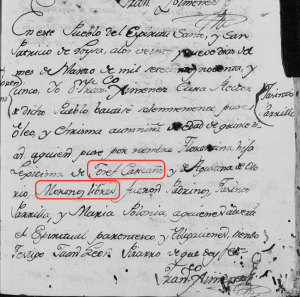 |
| Second Twin of José Carcaño, Moreno Libre, 1795 [FamilySearch] |
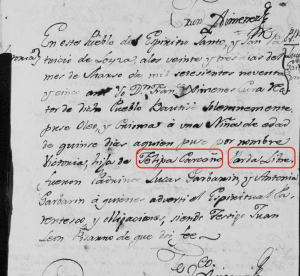 |
| Felipa Carcaño, Parda Libre, 1795 [FamilySearch] |

